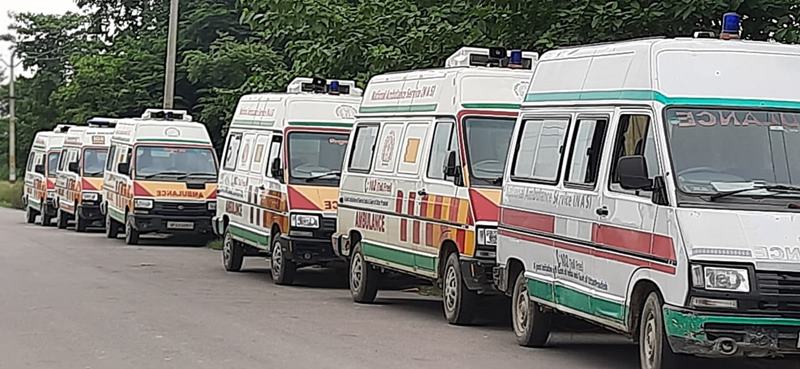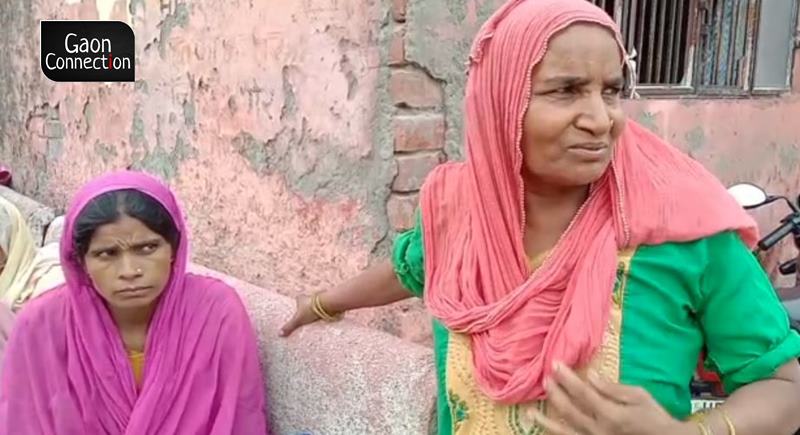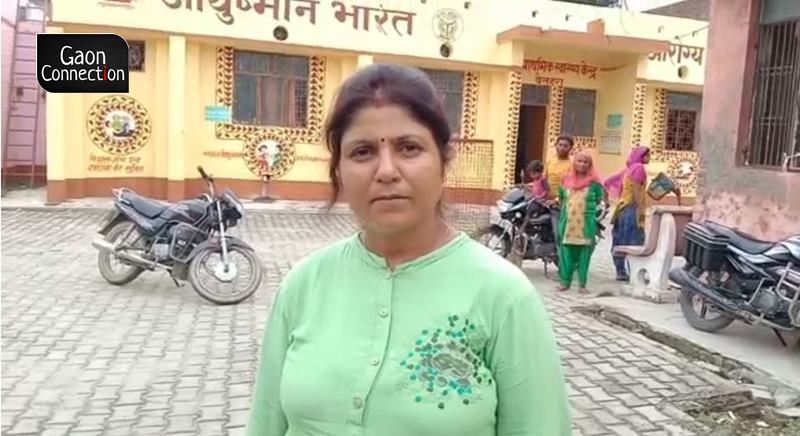Day 2 of ambulance strike in Uttar Pradesh, patients and pregnant women struggle to reach health centres
Uttar Pradesh government’s 102 and 108 ambulance services have come to a grinding halt due to strike by the ambulance drivers. Talks between the protesting ambulance drivers and the administration haven’t produced positive results yet. In the tussle between the state and the drivers, patients needing urgent healthcare are facing the brunt.

As the strike by the emergency ambulance drivers in Uttar Pradesh marked its second day today, on July 27, it was an anxious morning for 45-year-old Arvind Kumar as he, along with his relatives, woke up and scrambled to get an ambulance for his ailing father who writhed in pain.
“My father was having a hard time lying still on the bed due to pain in his abdomen. He couldn’t urinate due to pain. He was in pain all night but his condition worsened today morning,” Kumar told Gaon Connection, who after great struggle, had managed to bring his father to the district hospital in Unnao.
Kumar’s Dubepur village in Sikandarpur block is over 35 kilometers from the hospital where he had brought his father under emergency conditions. He informed how despite calling the emergency number 108, there was a long delay in the arrival of an ambulance due to the ongoing strike of ambulance drivers of 102 and 108 services in the state.
Also Read: Uttar Pradesh govt’s 102, 108 ambulance service grinds to halt as drivers launch strike
“We called for the ambulance at 7:30 am but managed to get one after 90 minutes. Those 90 minutes were a very difficult time for me as my father writhed in pain and I wasn’t certain if I would get an ambulance at all,” the 45-year-old narrated his ordeal.

“Finally we got my father to the district hospital in Unnao… This strike has been very traumatic for people like me,” he said.
Two primary ambulance services of the Uttar Pradesh government — 102 (delivery of pregnant women) and 108 (emergency service) — have come to a grinding halt since July 25-26 midnight, as the ambulance drivers across the state have gone on an indefinite strike.
Till now GVK EMRI (Emergency Management and Research Institute) was operating advanced life support system (ALS), 108, and 102 ambulance services in the state. Now the responsibility of the ALS ambulance service has been given to Ziqitza Health Care. The ALS ambulance drivers have launched a protest against the changes in their employment conditions and payment following the handover of the ambulance service tender to a different company.
The protesting drivers claim that the employment conditions offered by the new company are unjust and the government should be considerate towards their selfless service at a time when the COVID19 was at its peak. The general ambulance drivers (102 and 108 emergency service) have also joined the protests in solidarity and this has created fresh troubles for the healthcare system in the state.
An ordeal for pregnant women
About 100 kilometres from the district hospital in Unnao, where Kumar had finally managed to bring his ailing father, Shabana, a resident of Ghaghsi village in Barabanki district’s Fatehpur block, had a harrowing time making her heavily pregnant niece reach Belahra’s primary health centre (PHC), which is four kilometres away from her house.

Standing outside the premises of the PHC, where Gaon Connection met her, Shabana spoke about the nerve-wrecking time faced by her family. “We tried to get an ambulance but my niece was in intense labour pain. We had to resort to getting her here on a bike. Her husband brought her here and rode back to the village to get me to the PHC as well. It was very risky as any jerk or an accident could have been deadly,” the 55-year-old told Gaon Connection.
On the second day of the indefinite strike by ambulance drivers, many in rural Uttar Pradesh’s far flung areas are struggling to get their patients to a healthcare centre for timely medical treatment.
Gaon Connection managed to talk to some of them and found that many people used auto-rickshaws, private taxis, and even motorcycles to transport their patients to the healthcare centres in the absence of a readily available ambulance service.
Patients suffering, district admin asks drivers to make concessions
Meanwhile, Satya Prakash, the ambulance driver who brought Kumar’s father to the district hospital in Unnao, told Gaon Connection that merely one ambulance of 108 was at present functional in three blocks of Unnao district.
“Only cases like accidents and critical patients are being attended by this one ambulance. There is inconvenience for the patients but we have no option but to continue the strike till our demands are met,” Prakash said.
As per official sources, Unnao has a total of 90 ambulances of which only six were functional at present. Similarly, in Barabanki district, there are about 80 ambulances of 102 and 108 services of which at present only three were running for ‘emergency purposes’ during the ongoing strike.
P D Gupta, chief medical officer of Mirzapur district informed Gaon Connection that his district has a total of 65 ambulances but at present only there were operational. In Sitapur district, only six ambulances were in service during the strike.
ASHAs, ANMs are helpless
Accredited social health activists (ASHA) and auxiliary nurse midwives (ANMs) are the first line of medical personnel available for the rural citizens but attending critical patients is not their forte as they are trained to provide basic healthcare.
The ambulance strike has added to the woes of these health workers who are the backbone of India’s rural healthcare.

Also Read: ASHAs brave the second wave of COVID19. Without masks, sanitisers and rightful remuneration
“I have been trying to contact the ambulance services since morning and not a single call has been met with a positive response,” Neeraj Mishra, ASHA worker from Gursanda village in Sitapur district, told Gaon Connection. “I am not able to send the patients to the hospitals or PHCs/CHCs due to the unavailability of transport. I have no idea what would happen to those who need urgent healthcare,” she said helplessly.
Mishra’s concerns are echoed by an ANM named Neetu Singh who works in Barabanki. “Koi bike pe aa raha hai, koi rickshaw se aa raha hai, kisi ki raaste me hi delivery ho ja rahi to wo laut ja raha aadhe raaste se (Patients are reaching health centres on bikes, rickshaws and what not. Some pregnant women are delivering en route to the health centre. It’s a terrible situation),” Singh told Gaon Connection.
“We feel helpless because we often need to refer patients for higher health centres with better facilities but the ambulance strike has paralysed the system,” she added.
Gaon Connection tried to contact the chief medical officers (CMOs) of Sitapur and Barabanki but none of the officials were available for comments.
Stalemate continues
Meanwhile, Vivek Kumar, Unnao district head of the protesting ambulance drivers’ organisation — Jeevandayni Swasthya Vibhag — told Gaon Connection that a meeting was held today with Additional District Magistrate (ADM) of Unnao in order to find a solution to the crisis.
“ADM Rakesh Kumar came to talk to us and requested an end to the strike. We have submitted our demands to him as well. He also assured us that he is raising our demands with the concerned authorities in the state,” Vivek Kumar told Gaon Connection.

As per the news reports, the Uttar Pradesh government has warned the protesting drivers of being suspended from their jobs if they don’t resume their services.
Also, yesterday, on July 27, the Mirzapur CMO PD Gupta had told Gaon Connection that the Essential Services Management Act (ESMA) had been invoked against the protesting workers.
“The government has imposed ESMA on the protestors, they cannot impede emergency services like this. There are a total of 65 ambulances in the district but only three of them are functional as of now,” Gupta had told Gaon Connection.
Yesterday, on day one of the strike, Gaon Connection had approached the state’s Additional Health Secretary Amit Mohan Prasad to know about the government’s response to the crisis. “The negotiations are underway with the protestors and the MD NHM (Mission Director, National Health Mission) is responding to the issue,” Prasad had told Gaon Connection.
Reported by Mohit Shukla (Sitapur), Virendra Singh (Barabanki), Sumit Yadav (Unnao) and Brijendra Dubey (Mirzapur). Written by Pratyaksh Srivastava.

